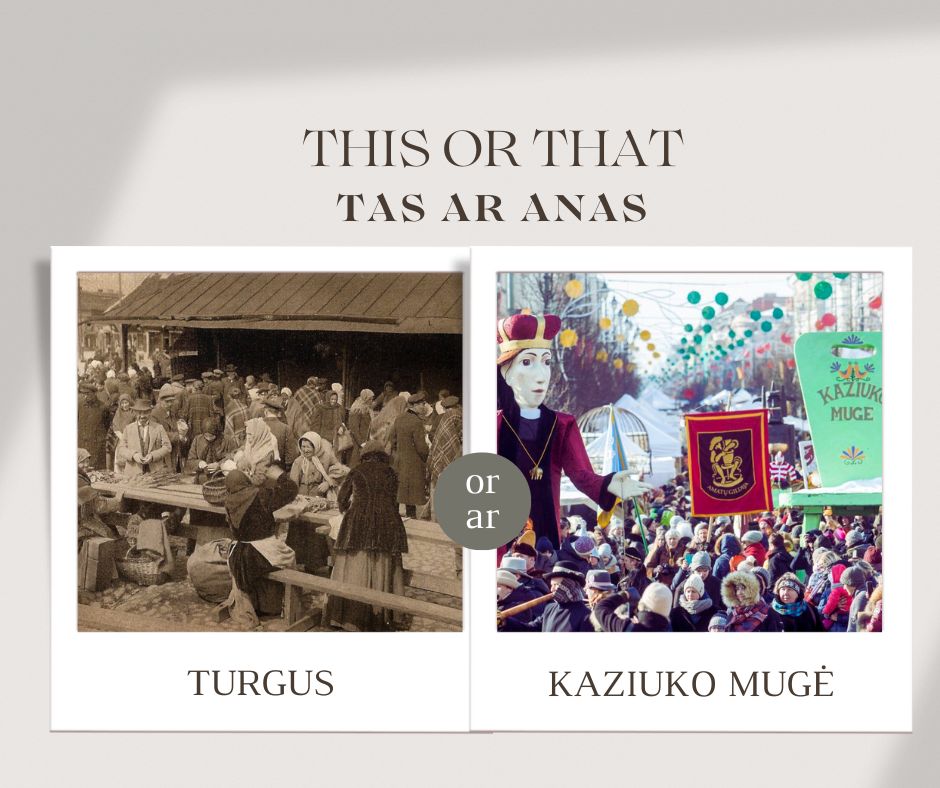
SPOTLIGHT ON LITHUANIAN CULTURE! CHAPTER 15: Lithuanian marketplaces

Marketplace
In ancient times, Lithuania had marketplaces where goods were brought to be exchanged, and later sold. They were surrounded by mobile homes, hostels, taverns, warehouses and craftsmen’s workshops. The number of markets increased dramatically in the second half of the 16th and early 17th centuries.
Markets promoted agricultural production, crafts and industry, and helped cities and towns to expand. Markets were held one to three times a week, depending on the size of the settlement, the number of inhabitants and the number of merchants in the area. Peasants and landlords sold grain, flax, honey, wax, hemp, furs, pigs, cattle, horses and birds, while craftsmen sold sledges, carts, wheels, tubs, harnesses, farm implements, household and domestic items. Market traders had to comply with the Vilnius weights (stones and pounds), which were used to pay the market fee to the manor governor or the city council, e.g. shopkeepers paid a graš to the Grand Duke’s court for each day they traded in the market, while butchers paid a sheep’s ham.
Information taken from https://www.vle.lt/straipsnis/turgus/
St. Casimir Fair
St. Casimir Fair dates back to the early 17th century. On November 7, 1602, Pope Clement VIII officially proclaimed Casimir a saint, and in 1636, Urban VIII proclaimed him a saint. St. Casimir was made the patron saint of Lithuania by St. Urbina. In the same year, the saint’s relics were solemnly transferred from the Jesuits‘ St. Casimir Church, where they had been preserved since 1604, and transferred to a specially built chapel in Vilnius Cathedral, where they remain to this day. It is believed that it was the transfer of the Saint’s remains in 1636 that began the history of the Kaziukas Fair. This is when the Cathedral began to host the Feast of St. Casimir, and the so-called “kermos” (from the German “kirchmesse”), the trade and entertainment following the church festivities, has always been an integral part of the feast.
In 1827, Vilnius merchants secured the privilege of organizing a larger, multi-day market, the so-called “jomarka” (from the German “jahrmarkt” and Russian “jarmarka”). This was the beginning of the real St. Casimir Fair. Not only Vilnius residents participated, but merchants from further afield came, well. Therefore, “būdos”, temporary shelters or tents, were set up in the Cathedral Square.
The most important item for sale at the fair is a heart-shaped biscuit called “Kaziuko širdis”, decorated with drawings, names or special symbols. Another traditional purchase is the “barankių” (bagel) necklace. Many people also go to the fair to buy “verbos” (dried flower bouquets) and handmade tools used in everyday life.
LIKE WHAT THE LITHUANIAN WORLD CENTER IS DOING? SUPPORT US AT https://www.lcenter.org/donate/